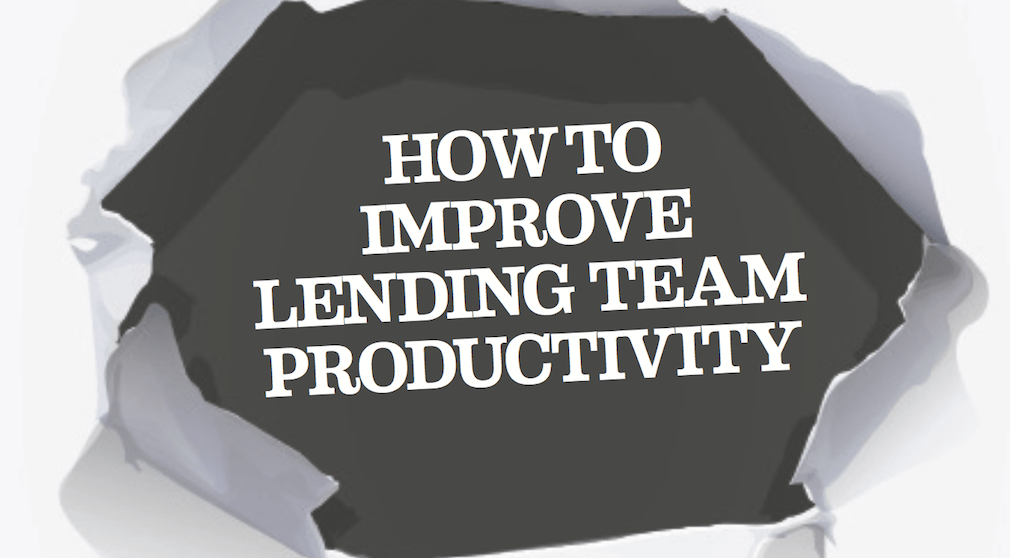While many lenders think they’re doing just fine with productivity, and processing loans with ‘good enough’ speed and efficiency, the numbers tell quite a different story completely. Through the lens of data, most shops are falling flat.
We’re going to share the insights we’ve gained from our six-year benchmarking study, including what the high-performing lenders are doing differently and how we can learn from them to solve common issues throughout the lending process.
What is productivity and why does it matter?
Arguably the most important profitability metric you should be tracking, productivity, measures the effectiveness of a lending team. Specifically, productivity measures the number of loans a team closed in any given month, or stated another way, closed loans per employee per month.
More than 50% of your cost to close is labor, so monitoring this metric helps management focus their attention on those activities that are affecting production and dragging down profitability. Steady improvement in productivity directly impacts the bottom-line.
There are four different ways to improve your productivity. Here they are:
1. Sit on the line
While most lending teams bristle at the notion that lending is akin to production line work, the truth is just like on a production line, certain actions must happen sequentially in order for all the parts to fit together properly. However, that’s where the comparison ends. The major difference today between Henry Ford’s Model T production line and a loan production line comes down to one thing: visibility.
On the auto production line, where the entire work floor was visible to the foreman, he could spot a line worker getting low on parts, and he would fix the gap by simply shouting to the restocking crew to replenish the worker’s supply. A worker who fell behind and was creating a bottleneck would be coached by a  foreman to resolve the issue. As a result, the communication on the assembly line was very open, visually and verbally, a key to having production glide along with high efficiency.
foreman to resolve the issue. As a result, the communication on the assembly line was very open, visually and verbally, a key to having production glide along with high efficiency.
Compare that to today’s knowledge work, like lending, and you can see how gaps and bottlenecks that stand in the way of efficiency are mostly hidden behind a multitude of work tools and are therefore harder to spot from any vantage. It begs the question, when was the last time you sat on the line and watched a loan go from application to close? If it wasn’t in the last six months, then you’re overdue for this exercise as you will experience the reality of what your team goes through to close a loan.
As industry changes dictate changes in the lending processes, your team members must undergo continual transformation in order for your shop to adapt. After years of focusing on heavy compliance regulations, we’re coming out on the other side looking at a stable, long-term purchase market. With an industry that is now very different than what it has been in the past, we’re entering uncharted waters that merit new mapping and navigation with fresh eyes.
Your job is simple at this stage as you sit on the line: Ask questions like a relentless 3-year-old. Don’t worry about fixing anything (that comes next), just observe, ask questions and let the discovery begin.
2. Map the loan journey
To avoid falling for the latest shiny object when evaluating technologies, it’s important to pinpoint the challenges that you see needs fixing. If you assume rather than know, you’re going to be an easy target for slick marketing and a sales pitch for the latest, greatest widget that may (or may not) increase your overall efficiency. If you’re looking to control your cost to close, then map the journey before you make any further investments in technology.
Mapping will help you focus on your process and take control of the future decisions you make. With a two-hour investment of time, a stack of colored sticky notes, a huge wall and your lending team, all will be revealed. You’ll all have a greater understanding of what you’re doing well or where there are duplications between people and technology exist. At every touch point of the loan, understand who is doing what and how the technology is laying on top. The map will tell you the true story and will help you design new processes that match the mortgage market of today, not yesterday.
When you complete this exercise, you’ll have a very clear understanding of your next steps. Where you see gaps or bottlenecks, design the best solution. Perhaps it’s retraining, cross training, new technology or optimization of existing technologies. Don’t guess here, this is critical thinking based on data.
One of the ways we support our clients at this stage is through an optimization report. It’s like a 100,000 mile tune up for your car that runs a full diagnostic of your systems. We run through a 100-point diagnostic to evaluate work flows and system processes to remove duplications of labor and technology, identify opportunities for retraining and make recommendations on your process. Any time we can bring best practices from our high-performance lenders to others we quickly catapult productivity.
3. Develop adaptable, customer-centric people
People are your most valuable asset, hands down. Without them your technology and processes wouldn’t function, and your customers would forever be searching for answers to a few simple questions. The most magical part of the experience for a borrower is when someone reaches out to them from across the lending abyss and extends a helping hand. Your people guide your borrowers through the process to reduce (dare I say eliminate?) pain and frustration.
Our six-year benchmarking study tells us exactly what high performance lenders do to get exceptional results from their team. The one thing every high-performance lender is doing is cross training their team to do every part of the loan, and every one of them is delivering an exceptional borrower experience. We know that because their market share, year over year, is higher than their peers and they consistently yield high productivity results.
Volume is affected by a myriad of macroeconomic forces but the bottom line is, the better your team is at moving together to where the work is, the better the efficiency. Your team must be trained in all aspects of the loan production so that they can go to where the work is as volume fluctuates. No more hiring when volume flows, and then letting people go when it ebbs; long-tenured teams are irreplaceable. No more stacked up work at one person’s desk. Everyone moves in cadence to swiftly and efficiently process every loan.
The truth is, every team member has an important role to play, but the power lies in your team’s collective ability to be great with technology, the process of lending and being exceptional with borrowers. There is so much value in possessing the special spark required to nurture the borrower or the complex knowledge around how to manufacture a mortgage, and so little fat for team members who don’t have these skills, that decisions around staffing become clear. Hanging on to people who have a fixed mindset, cling to old processes or are not open to change is just lazy leadership. Effective lending today requires that everyone is great with people and great with technology. It’s that simple.
4. Lean in to create a great place to work
One of your most important jobs as a leader is to encourage results without making your team feel like spokes in a wheel or gears in a profit-making machine. Move, move, move, faster, faster, faster. Where’s the heart? What’s the point of the work you do if you’re not having fun and developing positive relationships with the people you spend time with every day?
The highest-performing lender in our benchmarking study consists of a team that has been together for a really long time and experiences little to no attrition. No one wants to leave this team because they love coming to work. Why? Company culture and work environment have tremendous value to employees. Think of it this way, most people would rather be happy and earn a little less than be paid more and detest how they spend most of their day. This is especially true with the younger work force. If you want to attract up-and-coming top talent, our best advice is to invest in creating a value-driven culture of like-minded people.
True leaders are great at helping every employee, no matter their role, understand how the work they do positively impacts the broader mission.
5. Reinforce accountability and ownership
There are a variety of ways to reinforce process ownership and accountability within your team. Share the metrics with them to encourage ownership and talk them through why these metrics matter, how they’re calculated and then develop milestones to measure progress. Have team agreements as to how you work together for greater collaboration. We’ve found that when the entire team is focused on the same objective, they all contribute to significant upticks in profitability.
Lenders prepare for harsh lending conditions
After seeing several years of booming business, lenders began to struggle in the first quarter of 2018.
In the first quarter of 2018, independent mortgage banks and mortgage subsidiaries of chartered banks reported a net loss of $118 per loan originated, according to the Quarterly Mortgage Bankers Performance report from the Mortgage Bankers Association. This is down from a gain of $237 per loan in the fourth quarter of 2017.
Profits later rose once again, and lenders began making a profit during the remaining quarters of the year. However, the drop was troubling as it was the first time lenders reported a loss since the first quarter of 2014 when lenders lost $194 per loan as they dealt with rising compliance costs from the newly passed Dodd-Frank reform. In fact, this was only the second time lenders reported a loss since the MBA began conducting the report.
 But 2018 was only the beginning. Through the year, mortgage interest rates continued to rise, and home prices increased. In this difficult environment, 2019 could prove to be even more of a challenge.
But 2018 was only the beginning. Through the year, mortgage interest rates continued to rise, and home prices increased. In this difficult environment, 2019 could prove to be even more of a challenge.
As economists begin to adjust their forecasts for the year ahead, many predict the Federal Reserve will continue to raise interest rates, forecasting at least three rate hikes for 2019.
One expert, HomeStreet Bank Senior Vice President Andy McDonough, who has more than 20 years of experience in the mortgage industry, said that if current conditions continue, 2019 will shift to a buyer’s market. As home prices continue to rise alongside interest rates, affordability continues to decrease. As affordability falls, the housing market could see a significant decrease in interested homebuyers.
And mortgage lenders are already starting to feel it. For example, while Ellie Mae posted positive third-quarter earnings results, it was significantly lower than Wall Street’s expectations, and could even signal a slow-down ahead. The company revised its forecast down for its full-year revenue predictions, but company CEO Jonathan Corr said he was proud of the company for showing growth in the challenging mortgage origination environment.
Other lenders are already beginning to lay off staff in their mortgage departments as they find themselves unable to cope with rising costs of origination and lower profit margins.
For example, in October, JPMorgan Chase laid off nearly 400 employees in its consumer mortgage banking division. Wells Fargo laid off about 650 mortgage-related employees in August, citing the low volumes.
Unfortunately, the situation could get worse before it gets better. Economist predict that the next recession will begin in 2020, or even as soon as 2019. Nearly half of experts recently surveyed by Zillow said they expect the next recession to begin sometime in 2020, according to the company’s Home Price Expectations Survey, a quarterly survey of more than 100 real estate experts and economists.
Back in August last year, experts predicted there was a 73% chance of a recession by the end of 2020. Even former Federal Reserve Chair Ben Bernanke predicted the economy will be “going off a cliff” in 2020.





